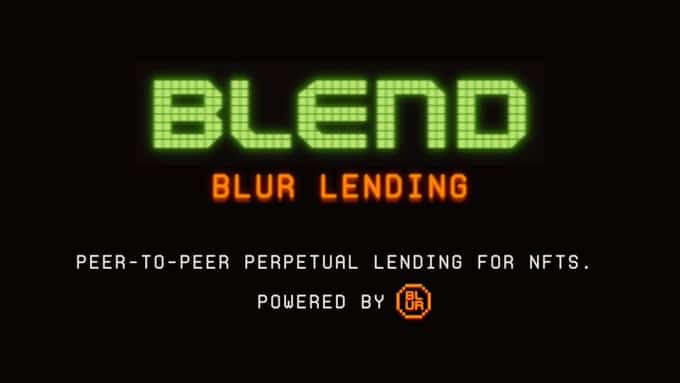If you’ve made a large investment into a blue-chip non-fungible token (NFT), options to access liquidity post-purchase are limited. As Blur cofounder Tieshun Roquerre (aka Pacman) puts it, “A lot of the time NFT enthusiasts are NFT-rich and ETH-poor.”
You can either sell your NFT or take a loan out against it using existing protocols, though existing NFT-lending protocols have short expiration dates that place the NFT itself at immediate risk.
Today, Blur is introducing a new product, a borrowing-and-lending protocol with perpetual loans, to solve these problems. Blend offers access to liquidity for NFT holders without specific expiration dates that can place the NFT at risk.
Learn more: What Is an NFT Marketplace?
Instead of expiration dates, loans have set amounts and rates, accruing interest until the balance is repaid. Lenders prepare loan offers to NFT collections, receiving a yield as well as the ability to liquidate their loan through a 30-hour auction.
What Are the Benefits of Blend?
Blend magnifies access to liquidity for NFT holders with a protocol that connects lenders with borrowers. The easy access to funds for NFT collectors creates another reason to own valuable NFTs: They’ll have access to better rates due to their value and prominence.
In addition, Blend creates financial opportunities for lenders to generate a yield on their assets. Lenders can choose to offer loans to established collections at low rates, or to more volatile ones at higher rates, depending on their risk profile.
Read more: Solana Is on a Tear. So Why Do Ethereum NFTs Remain Top Dog?
Blend also has benefits for NFT collections. NFT holders won’t need to liquidate their holdings as often, ideally leading to less selling pressure for existing collections, and more buyers for new ones.
What Are the Risks With Blend?
As with any financial agreement, there are some risks to keep in mind for both borrowers and lenders on Blend.
For borrowers, there is a risk that if the loan is not paid back, the interest accrued will exceed the value of the NFT. This would eventually result in the loss of the NFT if no action were taken.
Borrowers have a 24-hour period when a loan auction is triggered to pay their loan back. If they do not pay their loan back during this time, their loan’s interest rate increases rapidly to make buying it out more attractive to other lenders. This may result in borrowers being locked into a higher interest rate—up to 1,000% annual percentage yield (APY)—if someone else buys the loan out.
Read more: Blast Surges to $300M TVL, Rapidly Gaining on Top Ethereum L2s Amid Concerns
“If the interest rate increases and no one took the loan over, then it probably means the market conditions changed,” says Roquerre.
For lenders, there is a risk that the borrower will not pay their balance back, and also that no other lender will be interested in buying out the loan either, even at a higher interest rate. In this case, the lender will receive the collateralized NFT 30 hours after the auction is triggered. If it gets to this point, it is likely that liquidating the NFT will not cover the balance of the loan.
Blend Is Live Today
Blend is now live and accessible from the Blur marketplace. Specific collections already have Blend enabled.
The protocol was created by the Blur team in collaboration with Dan Robinson and Transmissions11 from Paradigm.
Blend’s Future
Blend is a part of Blur and subject to Blur DAO (decentralized autonomous organization) governance. The first 180 days of operation will include zero platform fees. After the first 180 days, the Blur DAO will decide on whether to change platform fees for borrowers, lenders, or both. The DAO will also decide on whether to change the 30-hour period for auctions, the maximum APY that can be reached, and other aspects of the protocol.
“Our goal as contributors from day 1 has been to grow the NFT space by increasing the liquidity of NFTs, and of course lending and financialization is a key aspect of that,” says Roquerre.
Blend has plans to expand in the near future with multiple refinancing options for both borrowers and lenders.
Blend is expected to become more decentralized over time. Current administrative access to the protocol exists from a multi-signature wallet that both makes the updates that the DAO dictates and also has the power to halt the protocol in case of an emergency.
Roquerre says, “It is beneficial to have some flexibility as you decentralize the stack as a whole, and then of course work to decentralize every nook and cranny as well.”
The Blend protocol contracts have been audited by CodeArena and ChainLight. Blend expects that after spending some years live on mainnet, the protocol’s control can be transitioned entirely to the Blur DAO.
Want to learn more about Blur and its founder Pacman? Don’t miss this episode of The Chopping Block!
“Update, Monday, May 1, 11:35 am ET: The article originally misspelled the name of auditing firm ChainLight. Unchained regrets the error.”


